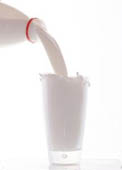
Purpose
To determine whether students can taste the difference between organic dairy products and inorganic dairy products.
Additional information
A component often found in inorganic dairy products, especially milk, is rGBH – a bovine growth hormone that is used by dairy farmers to increase the growth of cows and their milk production. This growth hormone is not present in organic dairy products, as organic farmers choose not to use this hormone when raising their cattle. Can people taste the difference in the products with rGBH in it and those without?
Sponsored Links
Required materials
- 1 quart organic milk
- 1 quart inorganic milk
- ½ lb. of organic cheddar cheese
- ½ lb. of inorganic cheddar cheese
- 1-2 cups of organic yogurt
- 1-2 cups of inorganic yogurt
- 1 gallon distilled water
- Plastic spoons, knives and forks
- Plastic cups
- Napkins
- Journal or notebook
- 10 volunteer students, 5 boys and 5 girls
Estimated Experiment Time
A few hours
Step-By-Step Procedure
- 1. Prepare the samples of organic and inorganic milk, cheese and yogurt. Label them with numbers so that only you will know which samples are organic and inorganic. Also prepare small cups of distilled water.
- 2. Have each student taste the inorganic milk sample first. Ask them to take a drink of water to clear their mouth of the previous taste and then have each student taste the organic milk sample. Is there a taste difference? If so, what tastes different about it? Ask each student to describe the taste of both the inorganic and the organic milk and whether they think the two samples tasted different. Record the students’ responses in your journal.
- 3. Repeat step two with both the organic and inorganic cheese and yogurt samples. Record the students’ responses.
Note
Try to find inorganic and organic milk, cheese and yogurt of the same brand, the only difference being whether it is organic or inorganic. This may be hard to do, however, so the brands may be different. If they are, make sure to list that as a variable in your experiment.
Observation
Write down the testimonies of the students after they taste each sample. You may begin to notice a pattern!
Result
Chart the results on a graph. Did the majority of the students determine there was a taste difference between the inorganic and organic foods? If so, which did the students like better? Do you think the bovine growth hormone rGBH is responsible for the taste difference? Do students like dairy products without rGBH in them better?
Sponsored Links
Take a moment to visit our table of Periodic Elements page where you can get an in-depth view of all the elements,
complete with the industry first side-by-side element comparisons!